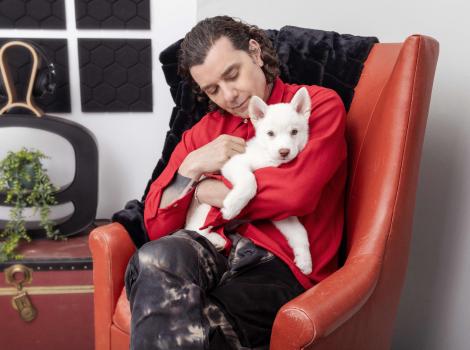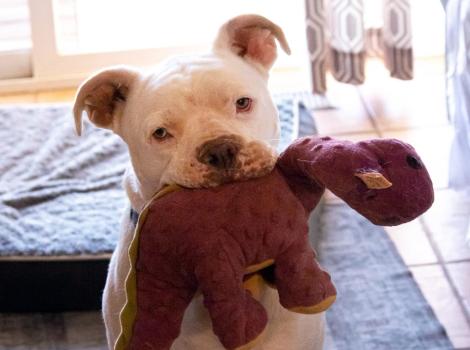Calming care for a pup with special needs

Kona is the bestest girl. She just needed some extra TLC to be her very best self. And that’s just what she received from her caregivers and the veterinary team at Best Friends Animal Sanctuary.
Best Friends’ goal is for all shelters to reach no-kill in 2025, and one thing that means is giving pets like Kona the individualized care they need to be matched with homes of their own.

Baffling behavior
Kona landed at the Sanctuary because she had some significant neurological issues that her family was struggling to help her with. She spun compulsively and had difficulty focusing her eyes and controlling her leg muscles. She also stopped eating, which was especially worrying because she was still a young dog who needed to gain weight.
[Faces of No-Kill: Solutions for dog with special needs]
Best Friends veterinarians sent Kona to a specialist, who diagnosed her with congenital (present from birth) nystagmus, a condition where her eyes make repetitive, uncontrolled movements. Nystagmus can affect vision, depth perception, and balance, making it difficult to focus steadily on an object, which can be unsettling and frightening.
“The nystagmus diagnosis made so much sense,” says Anabel Kirk, one of Kona’s caregivers. “Her constant eye movements made life feel dizzy and scary, leading to nausea, loss of appetite, spinning, and other nervous behaviors.”

Calmer days
Working with the veterinary team, Anabel and the other caregivers explored different medications and developed a feeding schedule to help minimize Kona’s symptoms.
“We gave her motion-sickness and appetite-stimulating meds, then found a combination of medication to calm her nerves and reduce stress,” says Anabel.
[Adopting a dog with neurological challenges]
They also discovered that Kona loved, loved, loved car rides. “Car rides were huge,” says Anabel. “She was calm when she was in the car. She would be gone all day with the landscaping crew, either sleeping in the truck or helping them around the Sanctuary. It was so helpful to get her out and have her be calm for the day. When she came back, she usually ate her dinner, which was a huge win.”

Happy romps ahead
While Kona's condition improved at the Sanctuary, staff hoped a home environment would further her progress. “We decided to reach out to her original adopters,” recalls Anabel. “We asked what they thought about taking her back, and they let us know that they’d been thinking about Kona for months and said they would love to take her back. We were over the moon.”
When Kona saw her original family again, she could hardly contain herself. Whines, yelps, and wiggles took over, and she fell into their arms. “Kona was so excited to see them,” says Anabel. “Her whole face changed when she saw them, and she ran right up to them. We were all just in tears. It was just such a happy moment.”
Nowadays Kona’s living her bestest life on a ranch in California, romping happily with her best doggy friend, Saylor. She’s gained weight, and while her eyes will always have a bit of a twitch, she no longer spins compulsively. In fact, the only spinning she’s doing now is around the yard with Saylor. The bestest life for the bestest girl.
Let's make every shelter and every community no-kill in 2025
Our goal at Best Friends is to support all animal shelters in the U.S. in reaching no-kill in 2025. No-kill means saving every dog and cat in a shelter who can be saved, accounting for community safety and good quality of life for pets.
Shelter staff can’t do it alone. Saving animals in shelters is everyone’s responsibility, and it takes support and participation from the community. No-kill is possible when we work together thoughtfully, honestly, and collaboratively.






